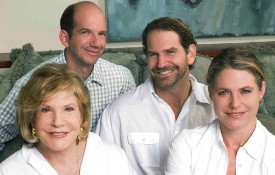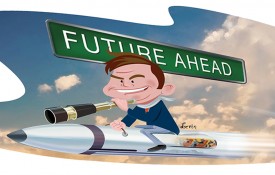Philanthropist and arts activist Dorothy Buffum Chandler graced Time’s cover in December 1964. The article stated that she embodied “perhaps the most impressive display of virtuoso money-raising and civic citizenship in the history of U.S. womanhood.” The beneficiary of her efforts was Los Angeles, which at the time was struggling to transform itself from a large community into a metropolitan city. Mrs. Chandler believed investing in the arts would bring prestige to the city and serve as the catalyst needed to reshape Los Angeles’ civic identity.
Mrs. Chandler’s role as a civic fundraiser began in earnest in 1950, when she undertook a successful drive to save the Hollywood Bowl. A few years later, she raised $37mm from private and public resources to build The Music Center in Downtown Los Angeles. Today, the Center is home to concert halls, a theatre, forum, pavilion, and grand outdoor public plaza, making it one of the premiere performing arts centers in the world.
Mrs. Chandler was a catalyst in her own right, opining in a 1964 interview that “there are so many people with good ideas and good intentions; they doubtless know more about the arts than I do. But I pull them together. That’s my job.’’ At the time that was no easy task.
Starting in the 1920s, Los Angeles’ population was growing rapidly, as millions of people came for the region’s good jobs, affordable housing, and welcoming climate. Though industrious, newer residents remained largely indifferent to local politics, which allowed a handful of incompetent, occasionally corrupt politicians to fill the void. That was bad for business, and a prominent group of insurance and finance executives, department store and oil magnates, and land barons decided to take action. They met regularly for lunch at Perino’s on Wilshire Boulevard to discuss the issues of the day and, if necessary, use their financial resources and political contacts to take action. This informal group became known as “the Committee of Twenty-Five.”

Their agenda was focused and limited to law and order and business-friendly city ordinances. Two of their initiatives helped reshape the City’s image—securing the appointment of Police Chief William Parker to professionalize and modernize the Los Angeles Police Department and supporting the building of a baseball stadium to persuade Walter Francis O’Malley to move his Brooklyn Dodgers to Los Angeles. Their third initiative—the Music Center—was largely shaped by Mrs. Chandler.
“Mrs. Chandler’s role as a civic fundraiser began in earnest in 1950, when she undertook a successful drive to save the Hollywood Bowl. A few years later, she raised $37mm from private and public resources to build The Music Center in Downtown Los Angeles.”
One weakness of the Committee was its collective tendency to focus solely on its business agenda. It ignored long-term and expensive infrastructure investments, such as paving city streets, building parks, and improving public transportation. A second weakness was its practice of excluding other influential residents because of their religion, neighborhood, and industry.
Mrs. Chandler’s strategy was to bridge this divide by nurturing a détente between the Committee, the Hollywood community, and the City’s growing affluent population further west. Entertainment titan Lew Wasserman, one of Mrs. Chandler’s favorite Angelenos, was the first to step forward, joining the Committee as its only Jewish member. (Wasserman’s involvement was contingent upon the Committee not meeting at the California Club, due to its exclusionary policies and a deal was brokered, with the help of Mrs. Chandler, to move their meetings to Perino’s.) This collaboration was the catalyst Mrs. Chandler needed to begin to raise the level of funds needed to build the Music Center.
Today the spirit of Mrs. Chandler lives on in Los Angeles’ civic community. The biggest difference from the past is that Los Angeles is now a mosaic of organizations that use inclusiveness and collaboration to advance initiatives for the “common good.” The Los Angeles Coalition for the Economy & Jobs, the Annenberg Foundation’s LA n Sync, the Southern California Grantmakers, the Home for Good Funders Collaborative, the CSU5, and the LA River Revitalization Corporation—to name a few—all bring together a diverse mix of leaders from business, academia, labor, and nonprofits to advance and implement initiatives that benefit those who live, work, and visit the Los Angeles region. A few examples stand out—the modernization of Los Angeles International Airport, new LA Metro rail and bus lines, more educational and healthcare opportunities for low-income residents, and a developing vision to transform the underutilized Los Angeles River into 51 miles of “continuous experience” that will include a waterway, new parks, residential neighborhoods, and urban centers.
Where are the new opportunities to reshape the civic image of Los Angeles?
Every day approximately 50,000 Los Angeles city employees report to work to support a vast network of public officials, boards, commissions, and approximately 42 departments and bureaus. Their intended goal is to provide efficient, reliable, and fair goods and service delivery to the residents, businesses, and neighborhoods throughout the City. Their challenge—budget cuts throughout the past five years—have greatly impacted City budgets, personnel, investment in technology, and programs.
Hilary Pennington of the Ford Foundation recently suggested that more attention should be paid by nonprofits, foundations, the public, and individual social entrepreneurs to the opportunities that exist in government to effect positive change. The Los Angeles Coalition for the Economy & Jobs agrees and that is why we are supporting a unique initiative with Los Angeles Mayor Eric Garcetti and the Mayor’s Fund for Los Angeles called the “Operations Innovation Team.”
This collaborative partnership brings together skilled talent from the private and public sectors to identify and execute improvements to the City’s least efficient business systems: the City’s $3B real estate portfolio, $7B procurement and contracting system, and workplace safety and wellness programs. These three initiatives, though challenging, show enormous opportunities for producing cost mitigation, revenue generation, and operational efficiencies. The development of two of these initiatives—real estate and procurement—will also help further economic development opportunities for the local region.
It is now up to Los Angeles’ collaborative forces to channel the spirit of Mrs. Chandler and seek out opportunities that will strengthen two of the region’s greatest resources – city government and its relationship with Los Angeles’ broad and diverse business and civic communities. After all, Mrs. Chandler showed us just how far you can go with some vision, collaboration, and personal/political will.















































